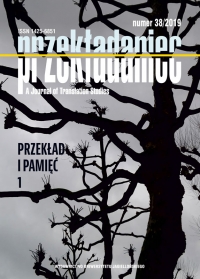„Niech pani im to opowie…” niesłyszane głosy w Shoah Claude’a Lanzmanna
“Why don’t you tell them…” Unheard Voices in Claude Lanzmann’s Shoah
Author(s): Karolina Kwaśna, Magda HeydelSubject(s): History of the Holocaust, Film / Cinema / Cinematography, Translation Studies
Published by: Wydawnictwo Uniwersytetu Jagiellońskiego
Keywords: Holocaust; Chełmno on Ner; Claude Lanzmann; Shoah; translation; bystander; trauma;
Summary/Abstract: Claude Lanzmann’s nine-hour documentary Shoah (1985) is a rich source of knowledge on the Nazi extermination of Jews in Central Europe. Its main material consists of interviews with people who witnessed the Holocaust, conducted in the very locations of the wartime events. The present paper analyses an iconic scene from Chełmno on Ner, where between 1940–1943 and later 1944–1945 the first Nazi death camp was located. A group of locals – gathered in front of the parish church, around one of the survivors of the camp – recall the events, sometimes in stunning technical detail. Their Polish utterances are translated into French; English subtitles are based on the French of the interpreter. The Polish linguistic material is not neutral: it is marked with dialectal and sociolectal features; the speakers engage in conversation on the side, comment on the situation of the interview in various ways, verbal and non-verbal. In the translation, both into French and English, sentences are skipped, the plurality of voices is flattened, and differences in memory are smoothed out. The resulting text is rather a summary than a translation. The paper offers close-up analyses of chosen sequences from the interview to show the complexity of the communication situation and the extent of distortion caused by the way translation works in the film. It also offers an alternative translation, which aims at giving voice to the actual people of Chełmno and acknowledging as fully as possible the complication and difficulty of memory construction through language, especially in a highly traumatic area. It hopes to offer insights into the bystander position in Holocaust discourse.
Journal: Przekładaniec.
- Issue Year: 2019
- Issue No: 38
- Page Range: 27-52
- Page Count: 26
- Language: Polish

